 |
 |
 |
| |
POINT-OF-CARE HEPATITIS C TESTING AND TREATING STRATEGY IN PEOPLE WHO INJECT DRUGS IN HARM REDUCTION AND ADDICTION CENTERS FOR HEPATITIS C ELIMINATION
|
| |
| |
AASLD 2020 Nov 11-16 virtual
Reported by Jules Levin
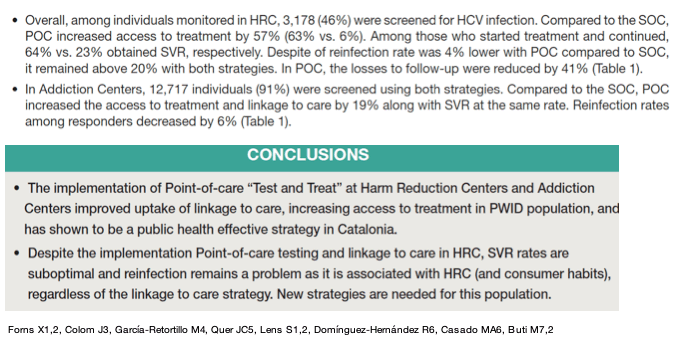
Forns X1,2, Colom J3, Garcia-Retortillo M4, Quer JC5, Lens S1,2, Dominguez-Hernández R6, Casado MA6, Buti M7,2
Xavier Forns, Servicio De Hepatologia, Hospital Clinic, Idibaps, Universitat De Barcelona; Centro De Investigacion En Red De Enfermedades Hepaticas I Digestivas (CIBEREHD), Joan Colom, Program for the Prevention, Control and Care of HIV, Sexually Transmitted Infections and Viral Hepatitis, Aspcat, Barcelona, Spain, Montserrat Garcia-Retortillo, Seccion d Hepatologia, Servicio De Digestivo, Hospital Del Mar, Joan Carles Quer, Servicio De Aparato Digestivo, Hospital Universitari Joan XXIII, Tarragona, Sabela Lens, Ciberehd, Instituto Carlos III, Madrid; Liver Unit, Hospital Clinic Barcelona, Idibaps, Universitat De Barcelona. Barcelona, Spain., Raquel Dominguez-Hernandez, Pharmacoeconomics & Outcomes Research Iberia (PORIB), Madrid, Spain, Miguel Angel Casado, Pharmacoeconomics & Outcomes Research Iberia (PORIB) and Maria Asuncion Buti Ferret, Liver Unit, Internal Medicine Department. Hospital Universitari Vall d'Hebron, Barcelona, Spain, University Hospital Vall D'hebron
Background: According to World Health Organization (WHO) goals, elimination of Hepatitis C Virus (HCV) by 2030 requires, from a public health perspective, to enhance and simplify HCV testing to increase diagnoses, and facilitate early linkage to care and treatment in risk groups with high HCV prevalence. Our aim was to assess different strategies of HCV testing, linkage to care and treatment among people who inject drugs (PWID) with chronic HCV infection in Catalonia.
Methods: Two strategies were analysed: Point- of-care (POC) "Testing and Treating" where HCV screening, treatment and follow-up were performed at the same place versus "Standard-of-care" (SOC) where chronic HCV positive PWID were referred to the hospital to treatment and follow- up. These two strategies were assessed separately in Harm Reduction Centers (HRC) with active drug users (6,878 individuals) or in Addiction Centers with opioid substitution therapy (13,944 individuals) . A different decision tree for each strategy was designed based on clinical practice and an Expert Panel opinion, from the Spanish National Health System perspective and a time horizon of 18 months . All the data included in the analysis were obtained from the literature and the Expert Panel.
Healthcare outcomes were HCV testing, linkage to care, treatment outcomes and reinfection.
Results: Overall, among individuals monitored in HRC, 3,178 (46%) were screened for HCV infection. Compared to the SOC, POC increased access to treatment by 57% (63% vs . 6%). Among those who started treatment and continued, 64% vs . 23% obtained Sustained Virological Response (SVR). Despite reinfection rate was 4% lower with POC compared to SOC, it remained above 20% with both strategies. In POC, the losses to follow-up were reduced by 41% . In Addiction Centers, 12,717 individuals (91%) were screening using both strategies. Compared to the SOC, POC increased the access to treatment and linkage to care by 19% along with SVR at the same rate. Reinfection rates among responders decreased by 6% (Table 1).
Conclusion: The implementation of POC "Test and Treat" at HRC and Addiction Centers improved uptake of linkage to care, reduced the reinfections in PWID population, and has shown to be a public health effective strategy in Catalonia. Although HCV screening and reinfection in HRC remain as future challenges, POC would help to achieve HCV elimination based on WHO`s goals.
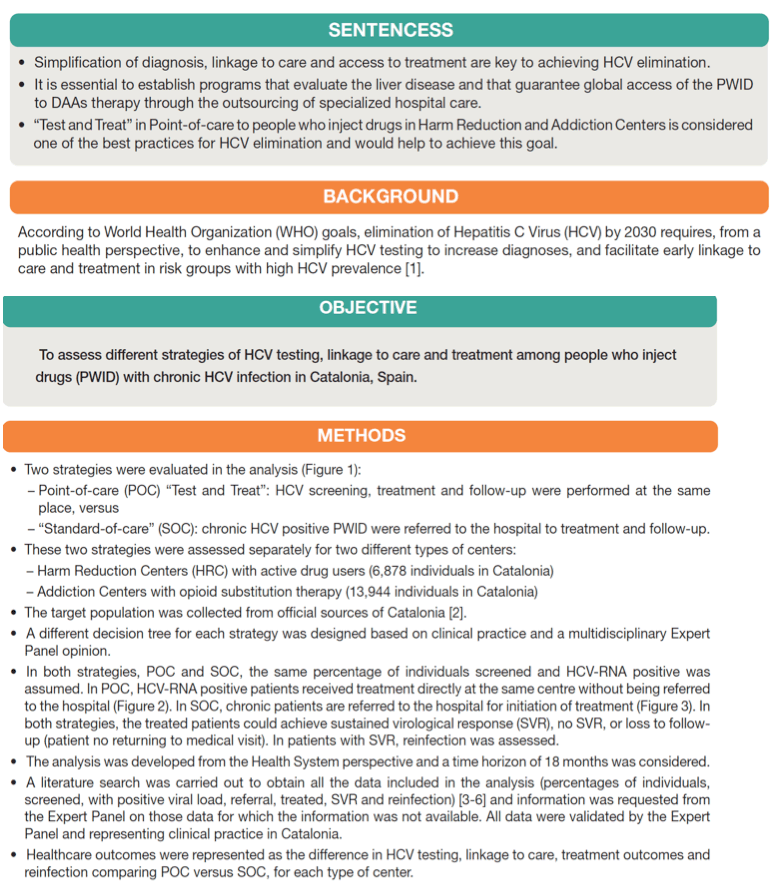
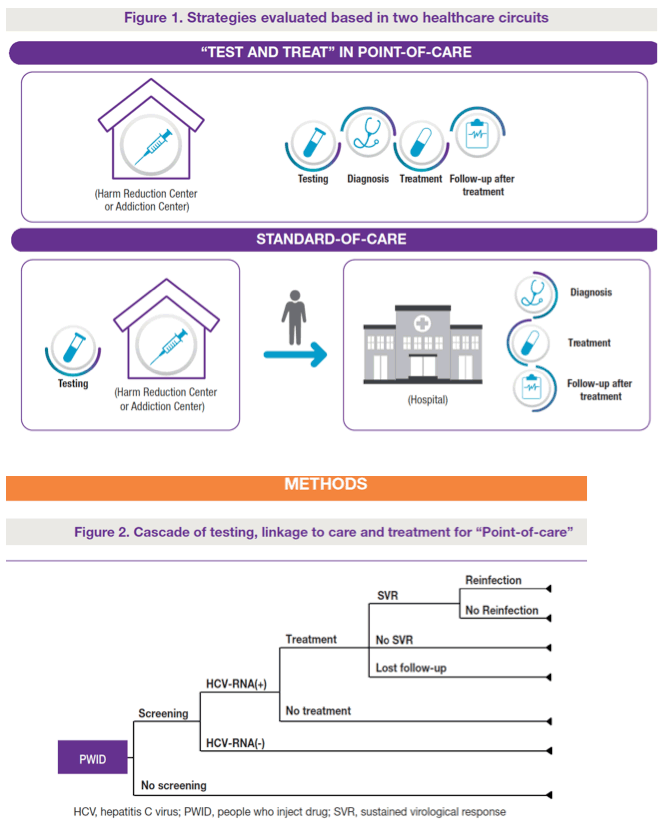

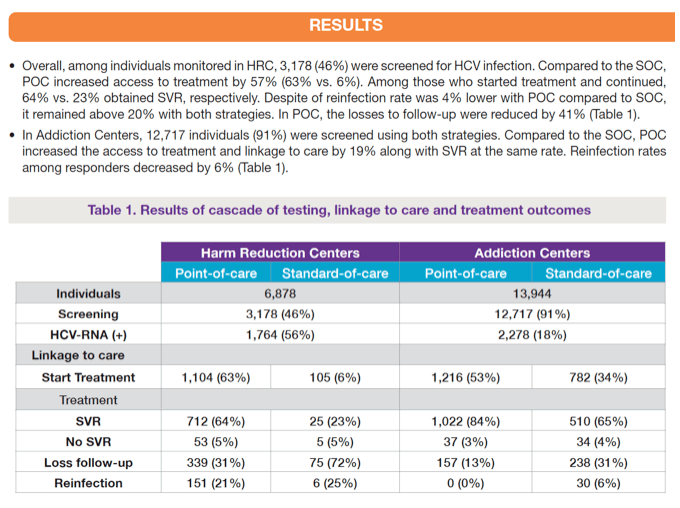
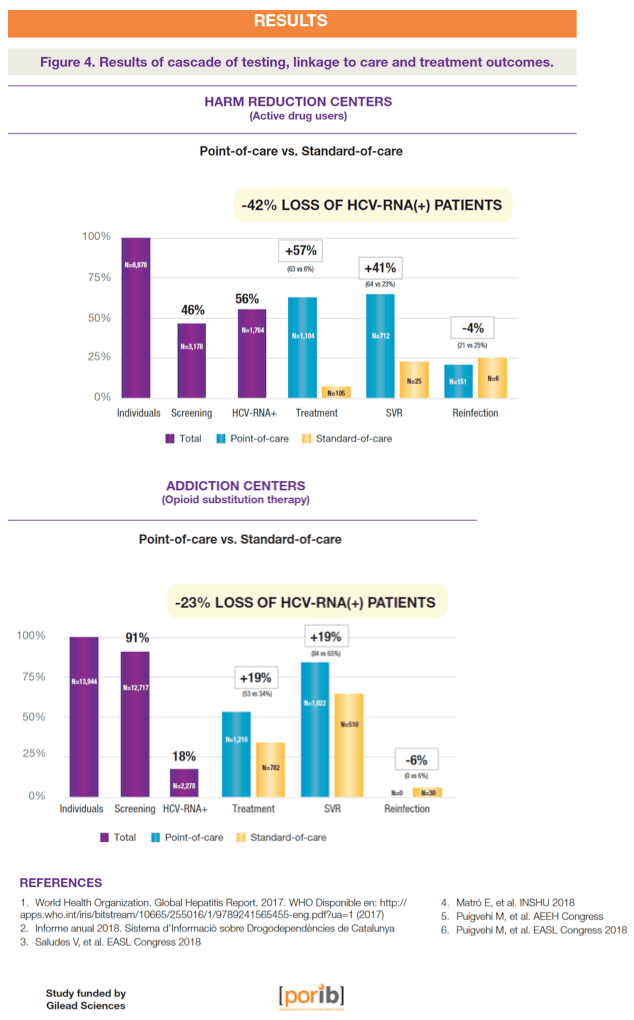
|
| |
|
 |
 |
|
|